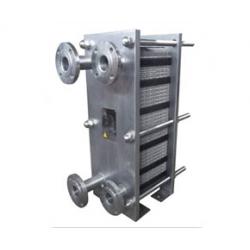Shandong Kanglu plate heat exchanger is a kind of heat exchanger which is made by pressing a thin metal plate into a heat exchange plate with a certain corrugated shape, then stacking it and using a frame plate and clamping bolts. The working fluid flows through the narrow, tortuous passage formed between the two sheets, and the hot and cold fluid flows through the interplate passage sheets for cold and heat exchange.
▋Parts material:
Heat exchange plate: SUS304, SUS316L, SMO254, titanium, nickel, Hastelloy
Gasket: NBR, H-NBR, EPDM, food mat, fluoro rubber, silicone rubber
Frame: stainless steel, outsourced stainless steel
Clamping bolt: stainless steel
Interface: rubber, stainless steel
Guide rod: stainless steel
Heat exchanger plate:
The flow rate is uniformly distributed, and the flow rate dead zone is removed, thereby avoiding corrosion caused by dirt accumulation, and at the same time improving the utilization ratio of the heat exchange area of the sheet.
The two fluids flow completely in opposite directions, greatly improving the heat exchange efficiency.
Parallel piping of the same kind of fluid inlet and outlet simplifies engineering installation.
A single plate simplifies maintenance.
▋Product Features / CHARACTERISTI
1. High heat transfer coefficient;
Since the different corrugated plates are inverted with each other, a complicated flow path is formed, so that the fluid flows three-dimensionally in the flow path between the corrugated plates, and turbulence can be generated at a low Reynolds number (generally Re=50-200), so heat transfer The coefficient is high and is generally considered to be 3 to 5 times that of the shell-and-tube type.
2. The logarithmic mean temperature difference is large and the temperature difference at the end is small.
In the shell-and-tube heat exchanger, the two fluids flow in the tube and shell, respectively, which are generally cross-flow, with a small logarithmic mean temperature difference correction coefficient, while the plate heat exchangers are mostly cocurrent or countercurrent flow. The correction coefficient is also usually about 0.95. In addition, the flow of cold and hot fluid in the plate heat exchanger is parallel to the heat exchange surface and there is no bypass flow, so that the temperature difference at the end of the plate heat exchanger is small, and the heat exchange with water can be Below 1 ° C, and shell-and-tube heat exchangers are generally 5 ° C fff.
3. Small footprint.
The plate heat exchanger has a compact structure, and the heat exchange area per unit volume is 2 to 5 times that of the shell-and-tube type. It is also not necessary to reserve the inspection and repairing place of the tube bundle as in the shell-and-shell type, so the same heat exchange amount and plate exchange are realized. The heater covers an area of about 1/5 to 1/8 of the shell-and-tube heat exchanger.
4. Easy to change the heat exchange area or process combination;
As long as a few plates are added or reduced, the purpose of increasing or decreasing the heat exchange area can be achieved; changing the plate arrangement or replacing a few plates can achieve the required process combination to adapt to the new heat exchange conditions, and the tube The heat transfer area of the shell heat exchanger is almost impossible to increase.
5. Light weight;
The thickness of the plate heat exchanger is only 0.4~0.8mm, while the thickness of the heat exchange tube of the shell-and-tube heat exchanger is 2.0~2.5mm. The shell-and-shell type is much heavier than the frame of the plate heat exchanger. Plate heat exchangers generally only have about 1/5 of the weight of the shell and tube.
6. The price is low;
Using the same material, the plate heat exchanger is about 40% to 60% lower than the shell-and-tube type under the same heat exchange area.
7. Easy to manufacture;
The heat transfer plates of the plate heat exchangers are stamped, highly standardized, and can be mass-produced. The shell-and-tube heat exchangers are generally hand-made.
8. Easy to clean;
The frame type plate heat exchanger can loosen the plate bundle and loosen the plate for mechanical cleaning as long as the compression bolt is loosened, which is very convenient for the heat exchange process of the equipment to be cleaned frequently.
9. The heat loss is small;
The plate heat exchanger only exposes the outer plate of the heat transfer plate to the atmosphere, so the heat loss is negligible and no heat preservation measures are required. The shell-and-tube heat exchanger has a large heat loss and requires a heat insulating layer.
10. The pressure loss per unit length is large;
Since the gap between the heat transfer surfaces is small, the heat transfer surface has irregularities, so the pressure loss is larger than that of the conventional smooth tube.
11. Not easy to scale;
Due to the internal full swing, it is not easy to scale, and its fouling coefficient is only 1/3~1/10 of the shell-and-tube heat exchanger.



